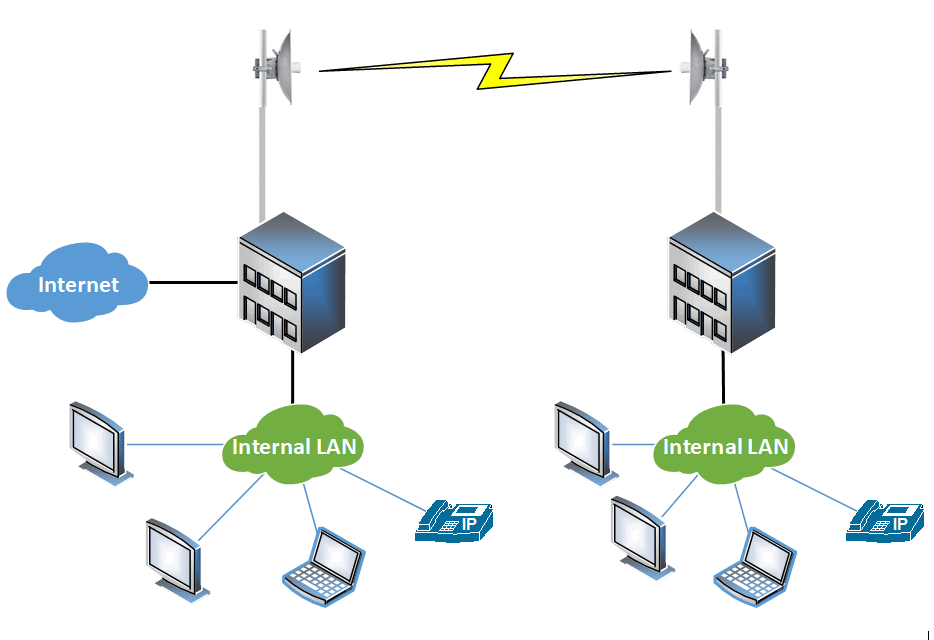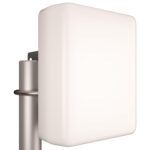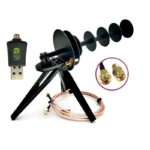Alternate title is “How to Borrow Wi-fi (in case of shifty neighbors)”

A Moment of Sanity…

If you are looking to create a network bridge between long distances(depicted in diagram above), and don’t want to bother laying cable down (I assume you can do this at same time, that you lay power down, bc otherwise what wifi equipment runs on no power?), I really suggest looking into a point to point wireless bridge product(below). It is actually designed for this purpose, and if you have access to the networking equipment on both sides, this would be the exact case that this equipment was engineered for.
Assume the below is the best sum of speeds that Pi zero is capable of:
“iperf data transfer rate measurement via USB”: 152 MBit/s.
“iperf measurements via WLAN”: 39.9 MBit/s (5m).
-https://www.hs-augsburg.de/homes/beckmanf/dokuwiki/doku.php?id=searchwing-pi-datarate
…return to Irrational Waste of Time
But if you have a bunch of old equipment you want to make use for, or just have access Wi-fi equipment on one side, this might be a side project for you.
Equipment:
To make this testing environment:

Primer on Wi-fi:
There are a few kinds of antenna.
There is
- the fictional isotropic point antenna. This is the power number that is published as the regulated limit on transmission power. The Maximum Effective Isotropic Radiated Power (EIRP), is based on this antenna.
- I believe most wifi antenna in laptops and client devices is a PCB antenna. If you’ve ever seen a microcontroller with built in wifi, the antenna is usually pretty prominent on the PCB, as the largest and simplest trace pattern, with no purpose connecting different components.
- The dipole/monopole antenna. The dipole antenna is the most common kind you see hanging off AP of wireless routers. These assume a disc like transmission field.
- The directional antenna, such as a panel antenna. These transmit/receive typically in 180/360 degrees.
- The highly directional antenna such as a yagi or parabolic antenna, which are extremely focused beams.
Let’s start
If you haven’t figured it out, we are experimenting with different antenna, to check their effect on range. And to lesser extent, quantify the effect of range, on thru-put.
Most AP and Wi-fi devices, do not allow you to change the antenna. I don’t know if this to keep their device within the confines of the regulations, since the maximum power rating is based WITH THE ANTENNA.
I have a USB wifi-n dongle that will allow me to change the antenna, and comes with a mono-pole antenna. I also have wifi-n based wifi to ethernet bridge, that will also allow you to change the antenna. It also comes with dipole antenna.
There is a cute trinket that allows you to turn a monopole antenna into a parabolic antenna, meant for drone radios.
I bought a professionally engineered wifi panel antenna, probably meant for warehouses, to keep range in one direction, in warehouse.
We do not have physical access to the neighbor’s wifi equipment, as they are already extremely suspicious that we asked for their wifi password.
The above are the tools at our disposal. The video is a dramatized presentation of the relatively boring results.
Below are the results, less dramatically presented:
Believe it or not that the designed wireless bridge produces the least throughput at 640Kbps(lower base “b” is bits per second, uppercase “B” is bytes per second, and yes they are interchangeable by factor of 8). My guess is a very low power CPU, and it simply can’t both handle changing wi-fi conditions, and forward frames to/from ethernet to wifi. It’s RSSI is for itself, and can’t be compared to the rest of the results. The wireless bridge was connected to Pi by ethernet, and created bridge to neighbor’s Wifi.
The USB adapter, with monopole (in video I called it a dipole, my mistake) antenna, produced better than expected results, and had better throughput than the wireless bridge, despite reporting a lower RSSI in iwconfig. It transferred 1.08Mbps. Same n protocol and frequency, as the bridge. The Pi client device directly connected to USB Wifi just handled it better. The Pi was probably more powerful.
The USB adapter, I added the parabolic dish to the monopole antenna, and it actually did increase the average RSSI from 57 to 62/100. And the throughput increased to 1.71Mbps. But it wasn’t physically secure, and it tended to act like a sail in the wind.
The antenna engineered to be a directional antenna, reported a lower RSSI (same USB adapter, for last 3 antenna), at 59/100, but produced an astounding increase of throughput to 6Mbps. So it might not just be a stronger signal, but receiving and sending a cleaner one. I can’t be sure, b/c I don’t know this secret sauce. But results speak for themselves.
———————-
Update 8/15/2024
We moved the wifi antenna to window, and from 25m away, got 35Mbps. Top speed of 50Mbps. Closer to other results of top speed. Obstructions matter.




